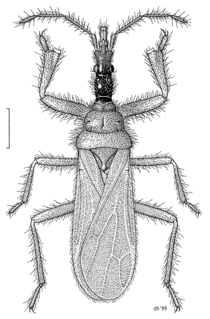
Enicocephalidae, also called unique-headed bugs and gnat bugs, are a family of around 300 species of the suborder heteroptera. They are typically 4 mm long, and found throughout the world. They have an elongated head, constricted in places, hence their head is 'unique'.

Rhopalosomatidae is a family of Hymenoptera containing about 68 extant species in four genera that are found worldwide. Three fossil genera are known.

Psychodidae, called drain flies, sink flies, filter flies, sewer flies, or sewer gnats, is a family of true flies. Some genera have short, hairy bodies and wings giving them a "furry" moth-like appearance, hence one of their common names, moth flies. Members of the sub-family Phlebotominae which are hematophagous may be called sand flies in some countries, although this term is also used for other unrelated flies.

Mantispidae, known commonly as mantidflies, mantispids, mantid lacewings, mantisflies or mantis-flies, is a family of small to moderate-sized insects in the order Neuroptera. There are many genera with around 400 species worldwide, especially in the tropics and subtropics. Only 5 species of Mantispa occur in Europe. As their names suggest, members of the group possess raptorial forelimbs similar to those of praying mantis, a case of convergent evolution.

Parasitiformes are a superorder of Arachnids, constituting one of the two major groups of mites, alongside Acariformes. Parasitiformes has, at times, been classified at the rank of order or suborder.

Opilioacaridae is the sole family of mites in the order Opilioacarida, made up of about 13 genera. The mites of this family are rare, large mites, and are widely considered primitive, as they retain six pairs of eyes, and abdominal segmentation. They have been historically been considered separate from other mites belonging to Acariformes and Parasitiformes, but are now generally considered a subgroup of Parasitiformes based on molecular phylogenetics.

The Cerophytidae are a family of Coleoptera known as the rare click beetles. Adults are infrequently encountered, and larvae are found within wood, where they are believed to feed on fungi. The family contains over 20 species in five genera, primarily distributed in the New World: 17 fossil genera are known extending to the Early Jurassic.
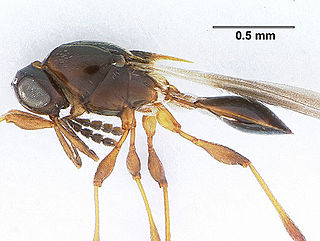
The Hymenopteran superfamily of parasitoid wasps, Platygastroidea, has often been treated as a lineage within the superfamily Proctotrupoidea, but most classifications since 1977 have recognized it as an independent group within the Proctotrupomorpha. It is presently has some 4000 described species. They are exclusively parasitic in nature.

Pelecinidae is a family of parasitic wasps in the Proctotrupoidea. It contains only one living genus, Pelecinus, with three species known from the Americas. The earliest fossil species are known from the Jurassic, and the group was highly diverse during the Cretaceous. Members of Pelecinus are parasitic on larval beetles, flies, green lacewings, and sawflies.
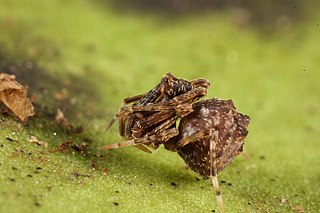
Archaeidae, also known as assassin spiders and pelican spiders, is a spider family with about ninety described species in five genera. It contains small spiders, ranging from 2 to 8 millimetres long, that prey exclusively on other spiders. They are unusual in that they have "necks", ranging from long and slender to short and fat. The name "pelican spider" refers to these elongated jaws and necks used to catch their prey. Living species of Archaeidae occur in South Africa, Madagascar and Australia, with the sister family Mecysmaucheniidae occurring in southern South America and New Zealand.

The Platycnemididae are a family of damselflies. They are known commonly as white-legged damselflies. There are over 400 species native to the Old World. The family is divided into several subfamilies.

Mesostigmata is an order of mites belonging to the Parasitiformes. They are by far the largest group of Parasitiformes, with over 8,000 species in 130 families. Mesostigmata includes parasitic as well as free-living and predatory forms. They can be recognized by the single pair of spiracles positioned laterally on the body.

Smarididae is a family of mites belonging to the order Trombidiformes. These large predatory mites have long oval bodies, distinctively pointed in front. They are usually red and densely hairy with slender legs, sometimes very long. They have either one or two pairs of eyes.

Epedanidae is a family of the harvestman infraorder Grassatores with about 200 described species. They are the sister group of the Gonyleptoidea.
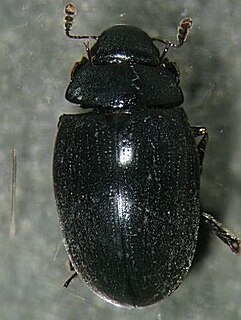
Nosodendridae is a family of beetles, with only 67 species in three extant genera: Several additional genera and species are known from the fossil record.

The Sclerogibbidae are a small family of aculeate wasps in the superfamily Chrysidoidea.

Uraraneida is an extinct order of arachnids, known from fossils of Middle Devonian, Permian and possibly Cretaceous age. Two genera of fossils have been definitively placed in this order: Attercopus from the Devonian of United States and Permarachne from the Permian of Russia. In 2018, a third genus Chimerarachne, from the Cretaceous of Myanmar was proposed to belong to this group, but this placement is disputed. When the first fossils were found, they were identified as spiders, but now constitute the Uraraneida, a separate but closely related group.
This list of fossil arthropods described in 2012 is a list of new taxa of trilobites, fossil insects, crustaceans, arachnids and other fossil arthropods of every kind that have been described during the year 2012. The list only includes taxa at the level of genus or species.
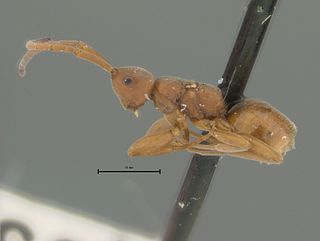
Embolemidae is a family of small solitary parasitoid wasps with around 70 species in 2 genera distributed around the world. The few species whose biology is known are parasites on planthopper nymphs of the families Achilidae and Cixiidae. There is debate regarding the status of the genus named Ampulicomorpha by Ashmead in 1893, generally considered now to be a junior synonym of Embolemus (e.g.,), though some authorities dispute this (e.g.,)
This list of fossil arthropods described in 2018 is a list of new taxa of trilobites, fossil insects, crustaceans, arachnids, and other fossil arthropods of every kind that were described during the year 2018, as well as other significant discoveries, and events related to arthropod paleontology that are scheduled to occur in the year 2018.



















